- Benefits of AR/VR for Energy and Utilities Sector: Expanding the Horizons
- Improved Training and Safety
- Advanced Maintenance and Repair
- Remote Assistance and Collaboration
- Proactive Asset Management and Monitoring
- Enhanced Operational Visualization
- Cost Reduction
- Enhanced Operational Efficiency
- Innovative Use Cases of AR/VR in Energy and Utilities Sector: Beyond the Basics
- Disaster Response and Emergency Preparedness
- Environmental Impact Assessments
- Consumer Engagement and Education
- Real-Time Compliance and Safety Inspections
- Design and Visualization of New Infrastructure
- Real-World Examples of Energy and Utility Businesses Using AR/VR in Their Operations
- Duke Energy
- Siemens Energy
- EDF Energy
- NextEra Energy
- Challenges of Integrating AR/VR in Energy and Utilities
- High Initial Investment
- Technical Complexity
- Training and Adoption
- Data Security and Privacy
- Reliability and Maintenance
- How Appinventiv is the Right Partner for AR/VR Integration in Your Energy and Utilities Business
- FAQs
In a world increasingly driven by technological advancements, the energy and utilities sector is no stranger when it comes to adopting innovation. Augmented Reality (AR) and Virtual Reality (VR) are not just experimental tools anymore but have become essential components in reshaping how we approach energy management and utility services. These technologies have the capability to transform traditional utility operations into dynamic platforms, significantly boosting overall safety.
Augmented Reality, on the one hand, allows technicians to see and interact with complex systems that are imposed on their actual environments, greatly reducing mistakes during maintenance tasks. VR, on the other hand, offers a safe, controlled setting where operators can practice handling dangerous tasks and learn critical skills without real-world risk.
Simply put, the integration of AR/VR in the energy and utilities sector marks a pivotal shift towards high-tech operational frameworks. These innovations not only streamline complex processes but also offer immersive training environments that enhance overall efficiency.
According to a Statista report, the overall AR/VR market size is expected to reach a valuation of $62 billion by 2029, witnessing a CAGR of 8.97% from 2024 to 2029. The significant growth in market value underscores the expanding role of these technologies in shaping future industry practices.
Thus, if you are a business ready to embark on a transformative journey that can help you maintain relevance and drive future growth, adopting AR and VR technologies is a strategic move. This initiative will not only help you with workflow optimization in the future but also set you apart in a highly competitive market.
In this blog, we will explore specific use cases and benefits of AR/VR for the energy and utilities sector. From improving operational accuracy to training employees in safe, controlled environments, let’s discover how these technologies are redefining traditional practices and setting new standards in the industry.
Benefits of AR/VR for Energy and Utilities Sector: Expanding the Horizons
Augmented Reality (AR) and Virtual Reality (VR) are revolutionizing the energy and utilities sector, offering not only enhanced operational efficiency but also improved safety protocols.
Let’s take a quick look at the specific benefits of employing ARVR in energy and utilities sector:
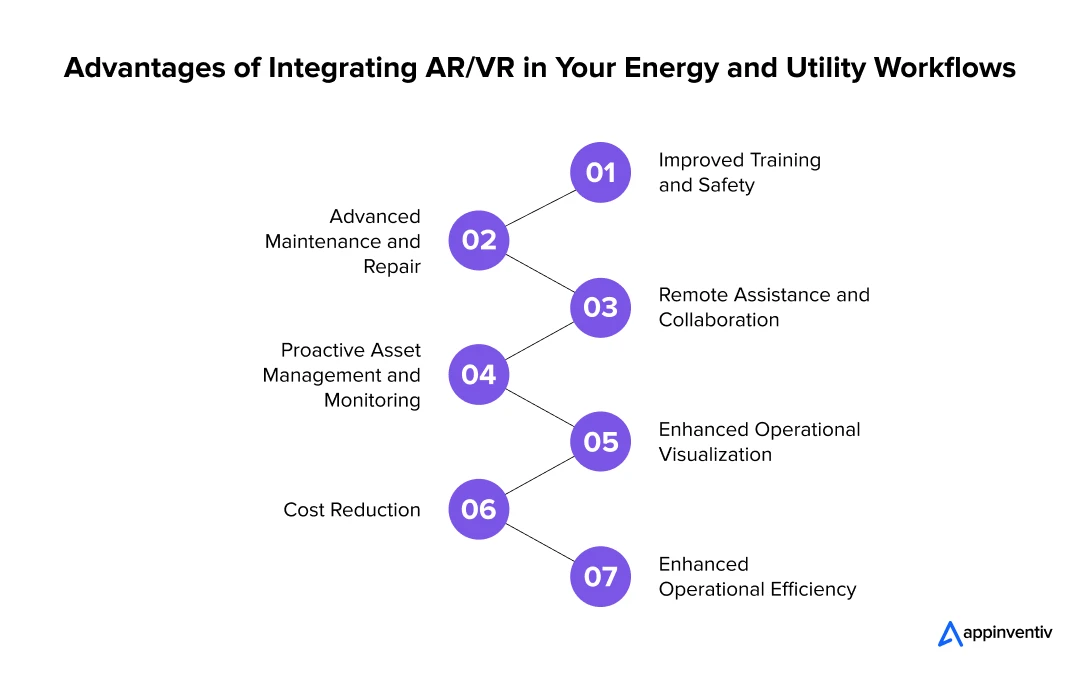
Improved Training and Safety
Overall improved employee training as well as better safety is one of the major benefits of AR/VR in the energy and utility sector. Virtual Reality offers a secure, immersive environment where employees can engage in virtual simulations of hazardous tasks. This method allows them to experience dangerous situations without real-life risks. It not only keeps them safe during training but also increases their proficiency and confidence in managing sophisticated equipment.
Advanced Maintenance and Repair
AR helps businesses perform maintenance and repairs more effectively. By overlaying detailed digital information onto the real-world components, the technicians can identify problem areas, access maintenance histories, and receive step-by-step repair instructions on their AR device. This reduces downtime and increases productivity.
Remote Assistance and Collaboration
AR enables effective collaboration by allowing remote experts to guide technicians onsite in real time. Using AR devices, experts can see exactly what the technician sees and provide step-by-step instructions. This reduces the need for travel, cutting costs and saving time while also improving the quality of field service by delivering expert assistance directly when required.
[Also Read: VisionOS App Development – Empowering Businesses for the Era of Spatial Computing]
Proactive Asset Management and Monitoring
Utilizing AR and VR for asset management allows companies to monitor their systems and infrastructure virtually. These technologies can predict and identify potential problems before they turn into challenges that can cause them money. Regular monitoring with AR and VR helps prioritize maintenance schedules and extends the lifespan of critical equipment while helping in ensuring continuous operations.
Enhanced Operational Visualization
AR boosts operational efficiency by showing real-time visuals of complex systems like power grids or pipelines. This allows operators to quickly see and understand system functions and spot any problems. Fast access to this information helps operators make quick decisions, ensuring the services remain stable and reliable.
Cost Reduction
Cost reduction is one of the most vital benefits of AR/VR for the energy and utilities sector. AR and VR technologies help lower costs by reducing the need for experts to travel, as they can guide technicians remotely using AR. These technologies also cut down on training expenses by replacing real-life practice with virtual simulations, and they help manage maintenance costs better by enabling detailed and proactive system monitoring.
Enhanced Operational Efficiency
AR and VR technologies significantly improve operational efficiency by providing workers in the field and operators in control rooms with real-time, actionable data. This immediate access to information speeds up decision-making and minimizes downtime, leading to more streamlined operations and improved productivity.
Innovative Use Cases of AR/VR in Energy and Utilities Sector: Beyond the Basics
AR and VR are transforming more than just basic operations in the energy and utilities sector. These technologies are introducing innovative applications that change the way we interact with and manage our energy resources. Let’s look at some of the vital use cases of AR and VR in this industry:
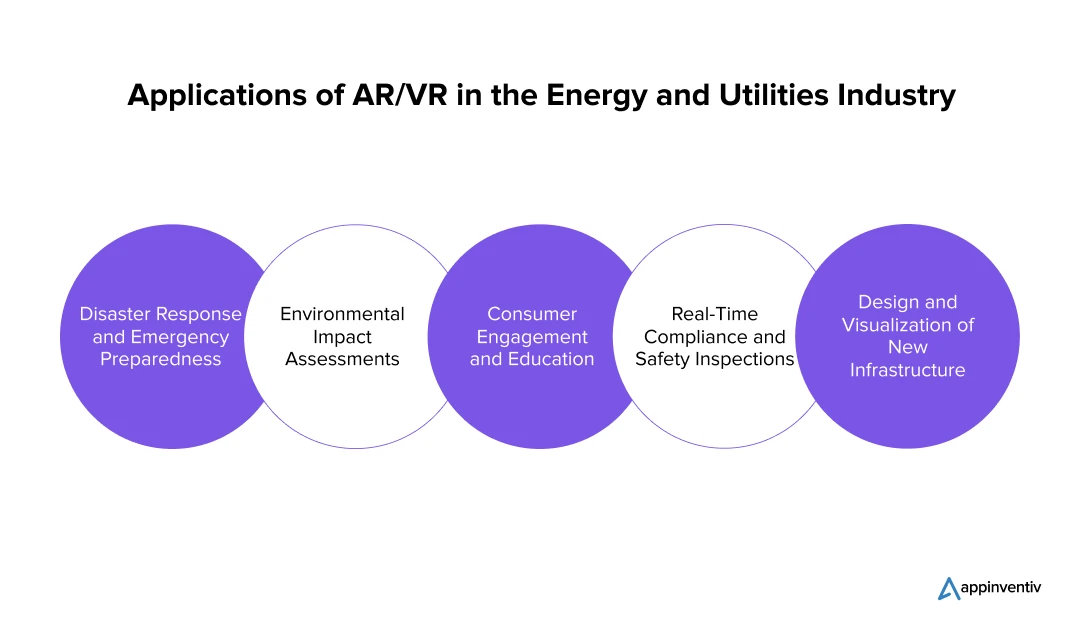
Disaster Response and Emergency Preparedness
AR and VR technologies are transforming how workers in the energy and utilities sectors train for emergencies. By engaging in realistic, controlled simulations of scenarios such as power outages, reactor malfunctions, or natural disasters, employees can safely experience and respond to high-stress situations.
This immersive training allows them to practice critical responses, refine their decision-making skills, and understand the protocols without any risk.
Environmental Impact Assessments
Assessing the overall impact on the environment is one of the major use cases of AR/VR in the energy and utilities sector. By creating detailed, immersive simulations, VR allows stakeholders to explore the potential effects of new infrastructure on the environment.
This includes visualizing changes in land use, checking the risks to local ecosystems, and understanding how projects might affect air and water quality. With these simulations, decision-makers can more accurately predict environmental outcomes and make informed choices to minimize the negative impacts.
[Also Read: How AI, IoT, and AR/VR Technologies are Helping Companies Achieve their Sustainability Goals]
Consumer Engagement and Education
Augmented Reality in utilities is revolutionizing how businesses interact with their customers. Through AR, the brand users can engage with interactive experiences that make complex energy concepts easy to understand.
For example, they can visualize their energy consumption in real time, see how small changes in behavior can lead to significant savings, or learn about the benefits of switching to renewable energy sources. These experiences not only educate but also empower consumers to make smarter, more sustainable choices.
Real-Time Compliance and Safety Inspections
AR/VR for the energy and utilities sector is changing how safety inspections and compliance checks are performed in the entire landscape. Inspectors use AR/VR devices to conduct evaluations right onsite, accessing crucial real-time data such as safety, equipment condition, and compliance requirements.
This setup helps quickly spot and address any issues, ensuring operations are carried out according to strict safety standards. AR not only makes inspections more accurate but is also less costly compared to traditional methods.
Design and Visualization of New Infrastructure
AR and VR technologies are essential tools in the planning and design stages of new energy facilities and infrastructure projects. These tools allow businesses to create 3D models of required installations in a virtual space. By visualizing these models, they can explore different design options, identify potential issues, and optimize layouts before construction begins.
This capability significantly reduces the likelihood of costly changes during the building process and ensures that projects are completed efficiently and on time.
Real-World Examples of Energy and Utility Businesses Using AR/VR in Their Operations
Augmented Reality and Virtual Reality in the energy and utilities industry are not just innovative concepts but have become practical tools that have been adopted by these companies worldwide. Let us look at some of the real-world examples of businesses effectively using AR and VR to advance their operations.
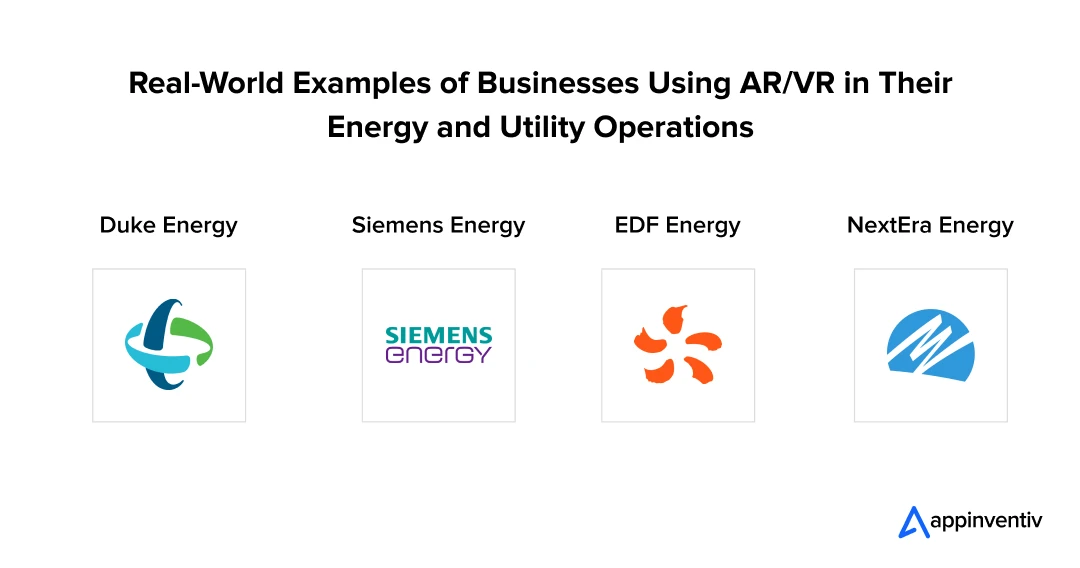
Duke Energy
Duke Energy, a leading energy company in the United States, uses Virtual Reality to train employees on safety and emergency procedures. They use VR to simulate handling hazardous materials and managing high-risk situations at power plants. This training method safely prepares employees for emergencies by letting them practice responses in a risk-free virtual setting, greatly enhancing their real-world readiness.
Siemens Energy
Siemens Energy utilizes Augmented Reality in energy plants to enhance maintenance and the overall repair work. Technicians equipped with AR glasses can access real-time visual instructions and crucial system data directly from the machinery they are working on. This helps them speed up repairs, boost accuracy, and minimize equipment downtime, making maintenance routines more efficient and effective.
EDF Energy
EDF Energy in the UK leverages VT to train operators at their nuclear power plants. The operators use immersive VR simulations in a virtual control room, which allows them to perform maintenance tasks and respond to emergency scenarios safely. This realistic training environment helps operators gain valuable experience and practice handling critical situations without any real-world risks.
NextEra Energy
NextEra Energy employs Augmented Reality to conduct inspections and maintenance of its infrastructure, such as wind turbines and other renewable energy installations. Technicians use AR to view diagrams and essential operational data in 3D right in their line of sight. This capability paves the way for more accurate inspections and efficient diagnosis of issues, leading to quicker resolutions and less downtime.
After looking into various real-world examples of businesses leveraging AR/VR for energy and utilities’ operations, let’s move ahead and look at the multiple challenges that need to be navigated to fully capitalize the technology’s benefits.
Challenges of Integrating AR/VR in Energy and Utilities
Integrating Augmented Reality and Virtual Reality in the utilities and energy sector comes with a set of challenges that businesses must navigate to fully leverage these technologies. Let’s look at some of major challenges associated with AR/VR for energy and utilities sector:
High Initial Investment
Setting up AR and VR systems can be expensive. The costs include not just buying the hardware and software but also fitting these new technologies into existing systems, which can initially be expensive for businesses.
To mitigate the high initial costs, companies can start with pilot projects that targets only specific operations and then examine the impact and ROI of AR/VR solutions before going for full-scale implementation. Additionally, seeking partnerships that focus on technological innovation in the energy sector could also reduce initial costs.
Technical Complexity
Introducing AR and VR into existing systems can be technically challenging. Energy and utility companies might struggle with making new digital tools work smoothly with older systems, which can cause problems and disruptions.
Partnering with experienced AR/VR software development experts who understand the energy and utilities sector can streamline the integration process. Agile development and robust testing phases can also help ensure compatibility and minimize disruptions.
Training and Adoption
Learning to use AR and VR effectively can be difficult for staff. It takes time and continuous support to train employees and get everyone in the organization to adopt these technologies.
Developing comprehensive training programs that include hands-on workshops and virtual training sessions can enhance skill development. In addition to this, regular follow-ups and support can also help in facilitating smoother adoption across the organization.
Data Security and Privacy
Using AR and VR involves handling a lot of data, which raises concerns about keeping this information secure and private. Protecting sensitive data, especially when it involves critical infrastructure, is important.
Adopting advanced cybersecurity measures, conducting regular security audits, and complying with international data protection regulations can help safeguard sensitive data used in AR and VR applications.
Reliability and Maintenance
AR and VR systems need to be reliable, especially in the tough environments where energy and utilities operate. They need to be durable and able to handle harsh conditions without often breaking down.
Regular software updates can enhance performance while allowing the software to adapt to new challenges. Additionally, using cloud-based solutions can provide stable and scalable infrastructure support, reducing downtime and maintenance demands.
How Appinventiv is the Right Partner for AR/VR Integration in Your Energy and Utilities Business
We hope our blog has helped you understand how the energy and utilities sector is now advocating for AR/VR integration in its daily operations. If you are a business owner looking to hop onto this lucrative opportunity, we can help you integrate Augmented Reality and Virtual Reality into your workflows. Our team possesses deep expertise in developing and deploying cutting-edge AR and VR solutions tailored to the specific needs of your sector.
As a dedicated AR/VR development services provider, we recognize the challenges of integrating new technologies into existing systems. Our technical teams are proficient at managing these complexities, providing seamless integration services that minimize operational disruptions while maximizing the benefits of AR and VR technologies. Whether upgrading current systems or designing new infrastructures, our experts ensure that each solution is reliable and effective.
At Appinventiv, security and privacy are at the forefront of every project. We adhere to the strictest data protection standards to ensure that sensitive information remains secure, even in complex, data-heavy AR and VR applications.
Being a dedicated energy software development company, we help you embrace AR and VR technologies, supported by a team that is not only knowledgeable but also deeply experienced in guiding successful digital transformations.
Get in touch to start your journey with us and harness the power of AR and VR to enhance your operational capabilities.
FAQs
Q. How does AR/VR work in the energy and utilities industry?
A. To give you a brief idea, AR/VR significantly streamlines operations by overlaying digital information directly on the physical equipment. The AR/VR technology in the energy and utilities sector further enables businesses to visualize complex systems in their actual working environments, greatly enhancing their ability to understand and interact with these systems. Furthermore, AR facilitates more efficient maintenance and repair processes by providing immediate access to critical information where it’s needed, speeding up troubleshooting and reducing equipment downtime. This leads to high levels of productivity.
Q. How can AR/VR benefit energy and utility companies?
A. When it comes to understanding the benefits of AR/VR for the energy and utilities sector, these technologies can significantly help businesses by increasing operational efficiency, providing advanced training environments, facilitating precise maintenance and repairs, and much more. In addition to this, the impact of AR/VR on energy and utilities safety can also be witnessed through immersive simulations and real-time data visualization.
Furthermore, AR/VR in renewable energy management is one of the major benefits that is attracting businesses to invest in the technology. Their integration can lead to better resource management, allowing companies to monitor and control energy distribution more effectively and predict maintenance needs before issues arise.
Q. What challenges can AR/VR solve in the utility sector?
A. AR/VR in the energy and utilities sector can address significant challenges. They enhance safety by providing realistic simulations that prepare workers for emergency situations without actual risks. These technologies also improve maintenance precision by overlaying live data and instructions on physical equipment, reducing errors and downtime. In addition to this, these technologies have the capability to reduce operational costs by allowing remote expert assistance, cutting down on travel and onsite visits. They simplify complex operations, decrease maintenance errors, and improve onsite decision-making with visual data displays, enabling utility companies to operate more efficiently.
As these innovations continue to evolve and businesses continue to tackle these challenges with the integration of these technologies, the future of AR/VR in the energy industry promises to become even more integral, revolutionizing the sector by continually introducing more efficient, safe, and optimized solutions.
Q. What is the cost of developing AR/VR-powered software for energy and utilities businesses?
A. To give you a rough estimate, the overall cost to develop an AR/VR-powered software for the energy and utilities sector can vary from $40,000 to $300,000. The overall budget is further impacted by various factors such as the software complexity, features to be integrated, location of the hired software development team, tech-stack used, third-party integrations required, etc.
Besides the direct costs, it’s essential to consider the long-term cost benefits of AR/VR in the energy and utilities sector. Implementing these technologies can lead to significant operational savings, reduce the need for physical travel, and minimize downtime through efficient maintenance and training processes.


- In just 2 mins you will get a response
- Your idea is 100% protected by our Non Disclosure Agreement.

10 Use Cases and Examples of How Extended Reality (XR) is Driving Innovation Across Industries
Imagine a factory where engineers diagnose machinery issues using 3D holograms or a hospital where surgeons rehearse complex procedures in a fully immersive virtual space before operating on a real patient. These scenarios are not distant possibilities - they are happening today and are powered by Extended Reality - XR use cases. As a convergence…
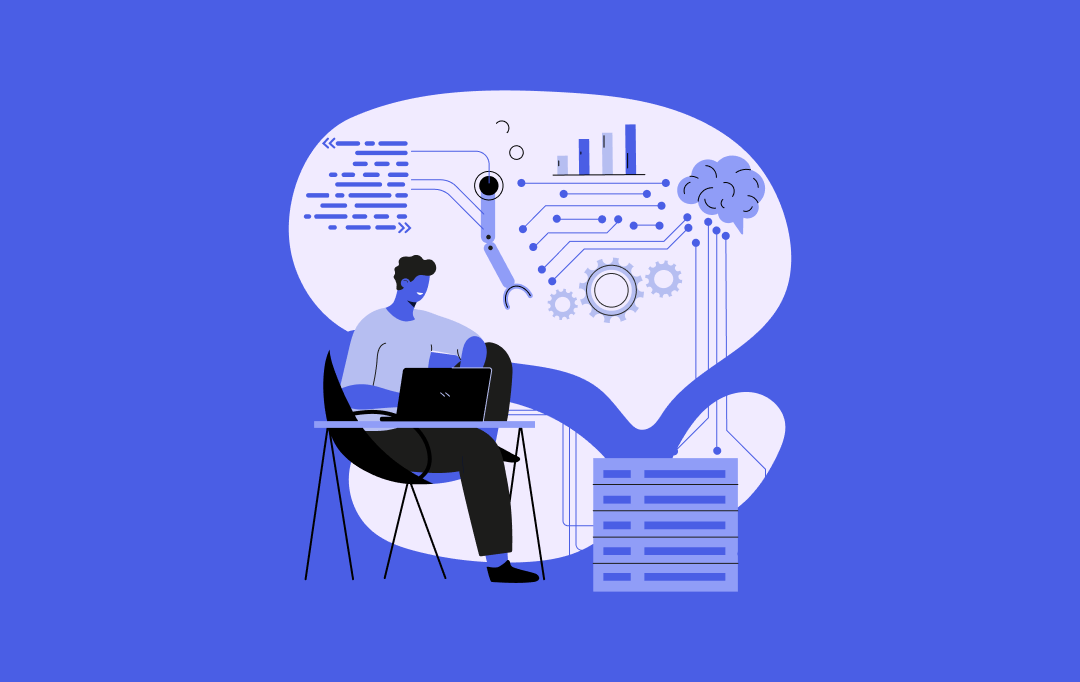
13 Use Cases and Examples of How Adaptive AI is Transforming Industries
Slashing downtime, boosting margins, automating workflow, and stealing your market share. You must be thinking that these buzzwords are Silicon Valley’s hype. No, these are the silent revolutions hitting Main Street industries. From manufacturing deploying demand forecasting to controlling production lines, healthcare tailoring predictive care and driving better outcomes. The success mantra—these industries are quietly…
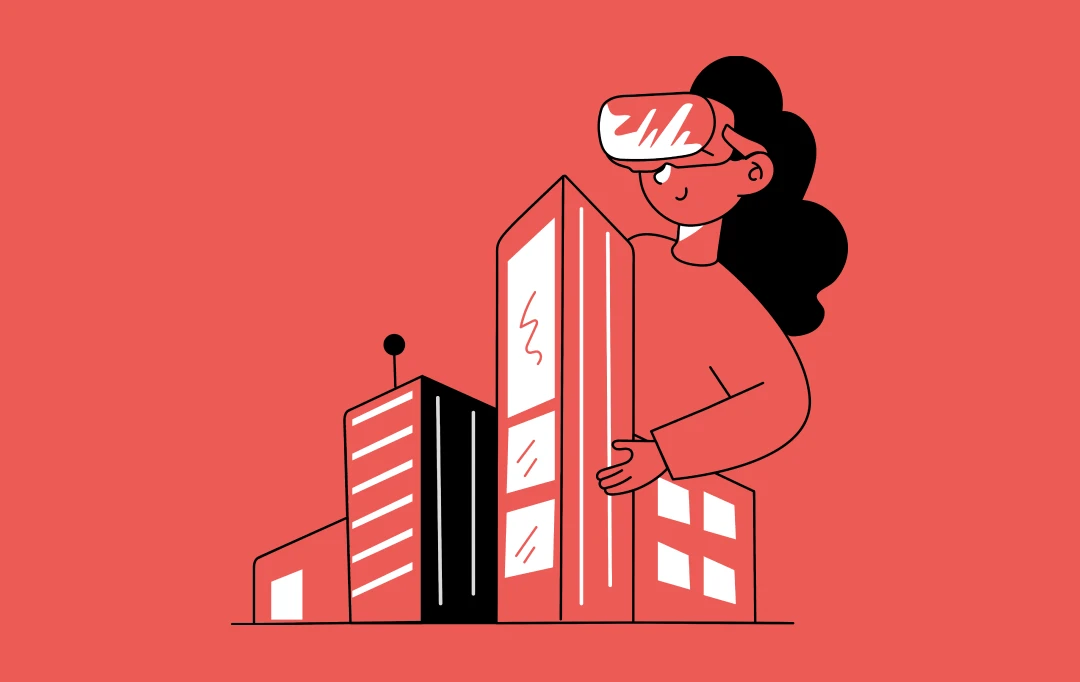
AR/VR in Construction - 10 Use Cases of How Augmented and Virtual Reality is Shaping the Industry
The use of extended reality technologies is one of the growing trends in the expanding domain of construction technology. As the sector gradually adopts more sophisticated practices, virtual and augmented reality in construction have emerged as revolutionary solutions. With compelling advantages like planning, marketing, and training, AR/VR technologies are transforming the face of construction. Prescient…
















